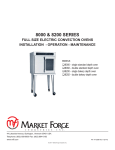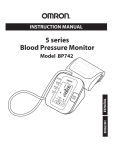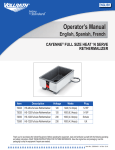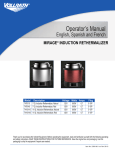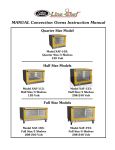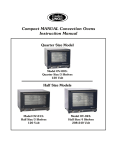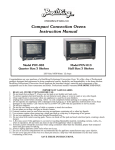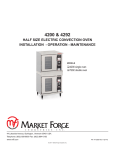Download Market Forge Industries CAPELLA - 10 Owner`s manual
Transcript
OWNER’S MANUAL CAPELLA STEAMER MODELS: INSTALLATION OPERATION MAINTENANCE STEAM COOKING CAPELLA - 4 CAPELLA - 6 CAPELLA - 8 CAPELLA - 10 CAPELLA - 12 GUIDELINES PARTS LISTS PARTS & SERVICE /DNHVLGH$YHQXH%XUOLQJWRQ97 Tel: ()Fax: () ZZZPILLFRP 315HY$ TABLE OF CONTENTS IMPORTANT NOTES FOR SAFETY, INSTALLATION AND OPERATION ............................................... 4 A. INTRODUCTION ............................................................................................................................ 5 1) Product Description .......................................................................................................... 5 2) Safety Features ................................................................................................................. 5 3) Dimensions ....................................................................................................................... 5 4) Service Contacts................................................................................................................ 6 B. SERVICE CONNECTIONS ................................................................................................................ 7 C. INSTALLATION ............................................................................................................................... 9 D. START UP PROCEDURE.................................................................................................................. 10 E. OPERATION .................................................................................................................................... 10 F. CLEANING GUIDELINES .................................................................................................................. 12 A. Daily Cleaning ................................................................................................................... 12 B. Monthly Cleaning .............................................................................................................. 12 G. STEAM COOKING GUIDELINES...................................................................................................... 14 A. Cooking with atmospheric/pressureless steam ............................................................... 14 B. Recommended uses.......................................................................................................... 14 C. Typical foods ..................................................................................................................... 14 D. Tips on cooking frozen product ........................................................................................ 14 E. Blanching ........................................................................................................................... 14 F. Tips on pan use.................................................................................................................. 14 G. Other helpful hints ........................................................................................................... 15 H. WARINGS AND CAUTIONS ............................................................................................................ 15 A. Warnings ........................................................................................................................... 15 B. Cautions ............................................................................................................................ 16 I. WIRING DIAGRAMS ........................................................................................................................ 17 A. 208/240 Volts ................................................................................................................... 17 Figure 1 .................................................................................................................... 17 B. 480 Volts .......................................................................................................................... 18 Figure 2 .................................................................................................................... 18 J. ILLUSTRATED PARTS LIST ............................................................................................................... 19 1. Cabinet assembly .............................................................................................................. 19 Figure 3 .................................................................................................................... 19 Figure 4 .................................................................................................................... 19 Figure 5 .................................................................................................................... 20 Figure 6 .................................................................................................................... 20 2. Door assembly................................................................................................................... 21 Figure 7 .................................................................................................................... 21 Figure 8 .................................................................................................................... 21 3. General assembly .............................................................................................................. 22 Figure 9 .................................................................................................................... 22 Figure 10 .................................................................................................................. 23 Figure 11 .................................................................................................................. 23 4. Control panel components ............................................................................................... 24 Figure 12 .................................................................................................................. 24 Figure 13 .................................................................................................................. 24 Figure 14 .................................................................................................................. 25 Figure 15 .................................................................................................................. 26 Figure 16 .................................................................................................................. 26 Figure 17 .................................................................................................................. 27 5. Convection Fan and Motor Components .......................................................................... 28 Figure 18 .................................................................................................................. 28 Figure 19 .................................................................................................................. 28 IMPORTANT NOTES FOR SAFETY, INSTALLATION AND OPERATION ! WARNING: This is the safety alert symbol. It is used to alert you to potential personal injury hazards. Obey all safety messages that follow this symbol to avoid possible injury or death. ! WARNING: Improper installation adjustment, alteration, service or maintenance can cause property damage, injury or death. Read the installation, operating and maintenance instructions thoroughly before installing or servicing this equipment. ! WARNING: Never spray water into electrical components. ! WARNING: Do not store or use gasoline or other flammable vapors or liquids in the vicinity of this or any other appliance. ! WARNING: Please make certain that every operator of this piece of equipment has been instructed on its proper and safe use, and has read and understands all warnings, cautions, and notes in this manual. This manual should be retained for future reference. Intended for commercial use only. Not for household use. It is recommended that this manual be read thoroughly and that all instructions be followed carefully. 4 A INTRODUCTION 1) Product Description: Congratulations on purchasing the Market Forge Capella. The Capella is a single compartment countertop or two-compartment floor model steamer featuring pressureless steam cooking and a circulating fan inside the cooking chamber to speed cooking. The cooking chamber of the Capella is treated with a scratch resistant, non-stick surface. A low water probe prevents the steamer from running dry an a ball valve drain is provided for easy safe draining. CAUTION: Do not use utensils, steel wool, or other harsh abrasives to clean your steamer. Scratching of the non-stick surface and stainless steel casing may occur. 2) Safety Features: As with any cooking process, or with any piece of commercial cooking equipment, there are potential hazards to both the operator and the piece of equipment if care is not taken. In designing the Capella steamer, safety features have been built in to protect against many of these potential hazards, but TRAINING OF EACH OPERATOR AND CAREFUL ADHERENCE TO ALL WARNINGS ARE NECESSARY TO ENSURE THE SAFETY OF USERS. a) Diagnostic sensor shut-off: The thermostat controller has a built in diagnostic feature that will automatically shut down all heaters if the sensor probe fails, which will avoid overheating. b) Low water shutoff In the event of a low water condition, the Add Water indicator light on the control panel will light up. If the steamer is not refilled within one minute, the steamer will shut down c) High Limit shutoff: If the steamer runs dry the heaters will shut down. d) Door open safety switch: There is a safety switch built into the door frame that shuts down heaters, fan and lights when the door is opened. Once the door is closed, all functions return. THE DOOR MUST BE FIRMLY CLOSED IN ORDER FOR THE STEAMER TO FUNCTION. IF STEAM IS ESCAPING, DOOR IS NOT PROPERLY SHUT AND MAY AFFECT COOK TIMES, PRODUCT QUALITY AND WATER CONSUMPTION. 3) Dimensions: 4-pan: External dimensions are 24” wide x 26¼” high (plus 4”-6” adjustable legs) x 28 ¾“ deep (plus vent pipe). 6-pan: External dimensions are 24” wide x 33¼” high (plus 4”-6” adjustable legs) x 28 ¾” deep (plus vent pipe). 8-pan: External dimensions are 24” wide x 52½” high (plus 6”-9” adjustable legs) x 28 ¾” deep (plus vent pipe). 10-pan: External dimensions are 24” wide x 59½” high (plus 6”-9” adjustable legs) x 28 ¾” deep (plus vent pipe). 12-pan: External dimensions are 24” wide x 66½” high (plus 6”-9” adjustable legs) x 28 ¾” deep (plus vent pipe). 5 4) Service Contacts: Should repairs be required, a network of authorized agencies is available to assist with prompt service. A current Directory of Authorized Service Agencies may be obtained by contacting: Market Forge Industries, Inc. Web Site: www.mfii.com 6 B SERVICE CONNECTIONS Models: Capella – 4 & Capella – 6 Capella Service Connections: EC D ELECTRICAL (Capella - 4) 60 Hz Electrical Connection – 1 1/8” knock-out hole for electrical connection. Rating provided on data label. Drain – A 6 ft. removable drain hose Voltage 208 240 208 240 480 pH 1 1 3 3 3 kW 8 8 8 8 7.2 Amps 39 33 22 19 9 ELECTRICAL (Capella - 6) 60 Hz NOTES: Voltage 208 240 208 240 208 240 208 240 480 pH 1 1 3 3 1 1 3 3 3 kW 8 8 8 8 9.8 9.8 9.8 9.8 9 Amps 38.5 33.3 22.2 19.3 47 41 27 24 12 4” clearance left mandatory, right and rear is recommended. Location near a floor drain is recommended. Refer to the electrical charts (above and to the left) for proper voltage requirements for each steamer. 7 SERVICE CONNECTIONS (continued) Models: Capella – 8, Capella – 10 & Capella – 12 Capella Service Connections: EC D ELECTRICAL (Capella - 4) 60 Hz Electrical Connection – 1 1/8” knock-out hole for electrical connection. Rating provided on data label. Drain – A 6 ft. removable drain hose Voltage 208 240 208 240 480 pH 1 1 3 3 3 kW 8 8 8 8 7.2 Amps 39 33 22 19 9 ELECTRICAL (Capella - 6) 60 Hz NOTES: Voltage 208 240 208 240 208 240 208 240 480 pH 1 1 3 3 1 1 3 3 3 kW 8 8 8 8 9.8 9.8 9.8 9.8 9 Amps 38.5 33.3 22.2 19.3 47 41 27 24 12 4” clearance left mandatory, right and rear is recommended. Location near a floor drain is recommended. Steamer sizes can be mix matched. Two 4-pan (Capella-4) stacked together makes an 8-pan steamer (Capella-8), a 4pan and 6-pan (Capella-4 & -6) stacked together makes a 10pan steamer (Capella-10), and two 6-pans (Capella-6) stacked together makes a 12-pan steamer (Capella-12). Refer to the electrical charts (above and to the left) for proper voltage requirements for each steamer. Each compartment, stacked or single, requires a separate electrical connection. 8 C INSTALLATION 1) Damage Inspection: Reporting shipping damage is the responsibility of the purchaser. Do not discard packaging if filing a freight damage claim. Upon receipt of steamer immediately inspect the exterior of packaging for damage. Remove wrapping. Inspect the exterior of the Capella for visible shipping damage. 2) Unpacking / removal from pallet: To remove the steamer from the pallet, carefully cut the strapping. 3) Legs / caster installation: Install 4 legs or casters (shipped inside the steamer) into the threaded mounting holes located on the base of the unit. If casters are supplied, locking casters should be on the front of the steamer. 4) Vent pipe installation (double & single compartment steamers): Steamers come with the vent piping in rear of unit completely assembled. DO NOT BLOCK VENT PIPE. 5) Drain Hose: Shipped inside the steamer is the hose used for draining the steamer. DO NOT DISCARD. 6) Physical location of steamer: 98% of all maintenance and service can be done from the front or left side. Some local codes may require installation under ventilation, but ventilation is not required in most cases. A minimum of 4” clearance from adjacent equipment on the left side and rear is recommended. NOTE: A location near water and a floor sink or drain is useful, but not necessary. NOTE: A qualified electrician must perform all electrical hookups and meet all local codes. Installation is the responsibility of the purchaser. 7) Electrical hookups: The access hole to electrically wire your steamer is located in the bottom right corner (facing the back of the steamer) on the rear panel. Your electrician may install a cord set to make the steamer more portable or the unit may be hard-wired. Please follow local codes when installing the cord set. NOTE: Stacked units will require 2 separate electrical connections. 8) Electrical Diagrams: The electrical diagrams are located on the inside of the left side access panel. 9) Recommended water quality: This steamer does not require filtered water. However, it is important to properly drain and clean your water reservoir at least daily (see 6.0 Cleaning Guidelines in this manual). NOTE: Low water probe will not sense water level if steamer uses de-ionized water or reverse osmosis water. 10) Ball valve drain: Drain is activated by a manual ball valve on the lower left front of the steamer. Turn counterclockwise to open, clockwise to close. Drain hose, supplied with steamer, must be connected to threaded drain before opening valve. WARNING: The water may be very hot. It is advisable to allow the water to cool down before draining. Leaving the door open will aid cooling. ! 11) Leveling: Once the legs have been installed and the steamer has been placed in its final location, the unit must be leveled. This is done by turning the base of the leg. Use the top of the steamer casing as a reference. It is recommended to use a level to ensure proper installation. WARNING: The steamer must be level in order for the low water sensor to function properly. ! 12) Rack Installation: Two pan support racks have been included with the steamer. Both racks are identical; there is no specific left or right side rack. To install, position a rack inside the cooking chamber so that the mounting bracket, with the ‘tear-drop’ shaped 9 hole, fits over the pre-installed rack screws at the top of the cooking chamber wall. The curved wires on the rack should be facing to the front of the steamer. Repeat this process for the rack mounted on the other side. These racks are designed to be removed easily for cleaning. 13) Function tests / inspection: Once your steamer is in place and properly leveled, plumbed and wired, test unit to make sure it is functioning properly. D STARTUP PROCEDURE 1) Using a soft sponge and mild detergent, wipe out the interior of the cooking chamber to remove shipping debris prior to use. Rinse with clean water. CAUTION: Do not use any abrasive cleaners, utensils or scrubbers on the non-stick coating. Use vinegar and water to clean reservoir. Nylon bristle brushes or soft sponges are recommended. 2) Make sure drain valve is in the CLOSE position. Fill the cooking chamber with 2 ½ gallons of water – or to about 1” below the door opening. Make sure water is above the level of the water probe on the lower left side of the cooking chamber. 3) Power on/heat up: Make sure the door is closed and turn the cooking mode selector to the 1 position. The Amber HEAT light on the upper left corner of the control panel will turn on. You may smell smoke from oils left from manufacturing – don’t be alarmed, they will burn off quickly. When the HEAT light goes out you are ready to test the steamer. 4) Turn the cooking mode selector switch to the 2 position. The HEATING light will go on as heat is called for. You may open the door and inspect the steaming process (note that the HEAT light goes out and the heaters are turned off when the door is opened). 5) Connect the drain hose and put the open end in a bucket or near a floor drain. With the door shut, open the drain and allow the water to drain below the water level probe. The ADD WATER light should illuminate. 6) To shut down your steamer, turn the cooking mode selector to the OFF position ( ). 7) Open the steamer door to allow it to cool and complete draining the cooking chamber. If draining into a bucket, remember that the cooking chamber can hold 2 ½ gallons of hot water. WARNING: The water hose or ball valve may be very hot. It is advisable to allow the water to cool down before draining. Leaving the door open will aid in cooling. E OPERATION 1) Electrical Connection: Make sure unit is plugged into a proper receptacle or wired properly and the breaker for the circuit is on. 2) Add water: Make sure drain valve is in the CLOSE position. Pour 2 ½ gallons of water into the cooking chamber through the door opening – or to about 1” below the door opening. Make sure water is above the level of the water probe on the lower left side of the cooking chamber. Water should not touch the bottom of the lowest pan. If the steamer is hot from prior use DO NOT add water to a hot, dry cooking chamber. Allow cooking chamber to cool with the door open first. 3) Reservoir fill / Add Water light: During the course of the day, as the water level decreases, the ADD WATER light (green) on the control panel will come on. If this light is on for more than one minute a safety sensor will shut down power to the heaters. The light will remain on until water is added. When water is added the cooking chamber will come back to the set temperature and resume cooking. If water is added and the ADD WATER light remains on, the water level sensing probe must be cleaned. Lower the water level until the probe is above water and clean probe with a sponge or cloth. Refill the cooking chamber. The ADD WATER light should go out. If water is not added or the probe is not cleaned within 15 minutes, the CLEAN PROBE light (red) will come on. When water is added, both CLEAN PROBE and ADD WATER light should go out. If the 10 water level sensing probe still needs to be cleaned, both lights will remain on until the probe is cleaned. CAUTION: Do not add water to a hot, dry cooking chamber. Damage to the cooking chamber may result. If the cooking chamber has run dry, let it cool before refilling. 4) Clean probe light: If the CLEAN PROBE light (red) is illuminated, the water level sensing probe is unable to sense water. The probe is on the lower left side of the cooking chamber. Lower the water level until the probe is above water and clean the metal portion of the probe with a sponge or cloth. When the probe is clean and water is added, the CLEAN PROBE light will go out. 5) Condensate trough: The trough under the door catches water dripping from the door and can be easily removed for emptying. 6) Power on / heat up: Turn the cooking mode selector switch to the desired setting, 1, 2 or 3. The steamer will begin warming up. The Amber colored HEAT light will turn on and remain on until the pre-heating is completed. Throughout the cooking process the HEAT light will come on periodically whenever the heaters are on. CAUTION: If the door is open, nothing will happen. Close the door and the steamer will turn on and begin warming up. 7) Door operation: The door must be closed at all times while cooking. If the door is opened during cooking, the heaters will shut down and the amber HEAT light will go off until the door is closed. You may open the door at any time to check the progress of cooking, stir product and add or remove cooking pans. If the door handle is loose the door is not firmly shut; re-shut the door by slamming firmly. 8) Pan combinations: Pan Size Quantity per 4-pan steamer Quantity per 6-pan steamer 12 x 20 x 1 ¼ 8 12 12 x 20 x 2 ½ 4 6 12 x 20 x 4 2 4 The Capella steamer accommodates 4” and 6” deep pans. However, for best steam cooking performance 1 ¼” or 2 ½” deep pans work best. Other combinations of these pan sizes will fit in your steamer. The steamer will accommodate gastronorm pans. 9) Cooking: When ready to cook turn the cooking mode selector dial to the desired setting: Setting Temperature 1 180° 2 212° steam plus radiant heat 3 Use for Green vegetables, delicate egg dishes, and seafood for higher yield. Cook times will be slower than steaming. Steam cooking Heavy dense foods like meat or potatoes, retherm frozen foods. NOTE: If starchy food products (potatoes, pasta) cause water to get frothy add 2 tablespoons of cooking oil to the water to control foaming. 10) Shut down and draining of steamer. a) Shut down: To shut down the steamer at the end of the day just turn the cooking mode selector dial to (OFF). b) Water reservoir draining: To drain the cooking chamber, first place the open end of the hose into a water receptacle (bucket, floor sink or floor drain) prior to attaching the hose to the steamer. Screw the hose to the brass fitting. Turn valve handle counter-clockwise to open drain. Once the water stops draining, turn valve handle clockwise to close drain and unscrew the drain hose from the steamer. Store the hose in a convenient location for daily use. 11 ! WARNING: The reservoir water may still be hot. It is advisable to let the water cool down prior to draining. NOTE: Opening the steamer door will speed the cooling process. It is also advisable to leave the steamer door open when not in use. This will lengthen the life of the door gasket. F CLEANING GUIDELINES 1) Daily Cleaning Once the power is off and the reservoir has been drained, a simple cleaning process should be followed: WARNING: The cooking chamber is designed to retain heat. It may still be hot to the touch when cleaning. Wear protective gloves, or wait for the surface to cool before cleaning. Do not add cold water to a hot, empty cooking chamber until it has cooled down, or damage may result. ! Lift the pan racks up and off mounting screws, and remove from the steamer for cleaning. Using a soft sponge, clean the non-stick coating on the interior of the cooking chamber. Clean the door gasket with gentle soap and water and allow to air dry. NOTICE: Only use mild soap, vinegar, and water to clean your steamer. Do not use abrasive utensils, caustic cleaners, or products containing chlorine, lye, or phosphorus (such as Lime-AWay). After cleaning, rinse thoroughly by wiping with a wet cloth dampened with fresh water. Never spray water on your steamer. FAILURE TO FOLLOW PROPER INSTRUCTIONS MAY CAUSE AN UNSAFE CONDITION AND/OR DAMAGE YOUR STEAMER, AND WILL VOID YOUR WARRANTY. Rinse the cooking chamber and door area with clean water. Rinse the cavity. Wipe with clean towel or soft sponge. Clean the water level sensor probe on the lower left interior with a sponge or cloth to remove ant mineral build up. The probe must be clean for the steamer to operate. To remove the white mineral deposits at and below the water line, spray vinegar directly on the mineral build-up using a spray bottle. For heavy mineral deposits, pour two cups of vinegar in the cooking chamber, fill to above the water level sensor probe with water and turn the steamer on for 20 minutes. Turn the steamer off and leave the door open. Allow to soak for several hours. Loosen mineral deposits with a nylon bristled brush. Drain, wipe and rinse with clean water. Wipe out the condensate trough located under the door. Remove food particles. NOTE: It is always advisable to leave the steamer door open when the unit is shut down for the evening. This will extend the life of your gasket. Your steamer is now ready for another day’s work! 2) Monthly Cleaning It is recommended to use the Stellar Descaling Powder to clean your steamer on a monthly basis or whenever necessary. 12 Make sure the steamer is off and cool. Drain water from the cooking cavity and wipe away any food debris. Make sure the drain valve is closed. Pour one pound of descaling powder per steamer into the bottom of the cooking cavity. NOTE: One pound is equal to 16 scoops (measuring scoop included), or one-half of a 2lb. jar of descaling powder. For Capella (manual water fill) Steamer: Pour 2 ½ gallons water into the bottom of the cooking chamber and set the control to Steam (#2) position. Allow the unit to reach steaming temperature and continue steaming for one hour. It may be necessary to add water before the hour is complete. If this is the case, add water, return to steaming temperature, and continue steaming until a total of one hour steaming has been reached. Turn the unit off, and allow it to cool for one hour. Drain the unit, and rinse the entire cooking cavity thoroughly If the unit is heavily scaled, it may be necessary to repeat the process. To reorder Stellar Descaling Powder, Part Number 92-1009 (case of four 2 lb. bottles), contact your local Parts and Service agency or: Market Forge Industries, Inc. Web Site: www.mfii.com 13 G STEAM COOKING GUIDELINES 1) Cooking with atmospheric / pressureless steam: Atmospheric or pressureless steaming is perfect for a la carte cooking. The door can always be opened during cooking to add or remove pans of food, to season food or to check on its progress. Multiple products can be cooked at one time because there is no crossover of cooking flavors in atmospheric steam. Large and small portions of food can be cooked at the same time. Less attention is required to cooking foods and over-cooking is rare. 2) Recommended Uses: a la carte thawing simmering preserving blanching poaching stewing rethermalizing cereals eggs meats poultry prepared foods sauces seafood, fresh or frozen 3) Typical Foods: casseroles, fresh or frozen desserts fruits pasta potatoes rice vegetables, fresh or frozen and much more 4) Tips on cooking frozen product a) Preheat cooking compartment. b) Break up frozen vegetables or product, if possible. c) If product is an ice block, set it in the pan on its narrowest side. This allows the steam to contact a greater surface area. d) Thawing is faster and better for the food in atmospheric steaming. e) Make sure frozen product is uniform in size to get best results. f) Season vegetables AFTER steaming. g) Less seasoning is required because steaming preserves natural flavors. h) When reheating prepared foods, stir occasionally to speed heating. i) Shallower pans will allow faster cooking times. 5) Blanching: Many foods can be blanched in atmospheric steam before being finished in ovens, fryers, or on grills and griddles. This reduces total cooking time, helps ensure complete cooking and a moist product. Potatoes, poultry and seafood are excellent examples. Blanching before frying reduces grease absorption by food products. 6) Tips on pan use a) For faster cook times, 2 ½” deep perforated pans are recommended. b) It is not necessary and we do not recommend covering most pans of product. When cooking with only one pan, place it in the center of the cooking chamber. 14 c) Use solid pans where appropriate: scrambled eggs, rice, beans, dehydrated foods, prepared casseroles, sauces, cake or other desserts (you can bake a cake in atmospheric steam), and when you want to prevent food from dripping on a lower pan. d) When cooking proteins (meat, poultry or seafood) use a solid catch pan under the perforated pan. Accumulated juices can be used for soup stock, gravy or broth. e) Protein foods (meat, poultry or seafood) can be cooked in perforated or solid pans. If you are batch-cooking protein foods use perforated pans and place a solid pan on the bottom rail. All the juices will then accumulate in this pan for later use and to keep them out of the water reservoir. f) When atmospheric steaming, a pan cover can increase the cooking time up to 400%. Items such as frozen casseroles, meat loaf, or sauces can be covered to avoid excess condensation. g) Root vegetables should be steamed in a perforated pan. h) Eggs can be hard cooked out of the shell and then chopped to avoid peeling shells. i) Always cook potatoes in perforated pans. This allows steam to circulate properly. 7) Other helpful hints a) Got a tough cleaning problem, pot, pan, utensil? Put it in your steamer to loosen burned-on food; it makes washing much easier. b) Stale or frozen bread can be thawed or renewed in your steamer. c) Allow adequate spacing between pans for even steam circulation. Your pan rails and the shape of the steamer walls are designed to maximize steam flow. Do not try to load more than the rack is designed for. Maximum capacity loads cook best with perforated pans. d) Loosely packed pans will cook faster than tightly packed pans. e) To skin tomatoes, oranges etc. more easily, steam for a short time, then chill in cold water. f) When steaming pasta, shrimp, or ground meat, nesting a perforated pan in a solid pan works well. Lift out the perforated pan to drain. g) Never have the water high enough or a pan low enough to touch water. Allow enough space for steam circulation. Steam has 6 times more energy than boiling water – use the steam to cook. h) When possible, cook in two shallow pans instead of one deeper one – it cooks faster and you avoid bruising the product. i) If using ½ size or smaller pans on one level, with different products, load the faster cooking items last, this will make unloading easier. j) In steam cooking, load size has little effect on the cooking time. For the highest efficiency cook with full loads. k) Pre-cook roasts, especially fat-encrusted roasts, in steam for 1/3 of their cooking time, then place in oven. Juices are sealed in, there is more flavor, more nutrients are retained and the roast shrinks less. l) Cook whole poultry the same way, only cook it until it is nearly completed and allow just enough time in the oven to finish and brown. H WARNINGS AND CAUTIONS 1) Warnings a) A qualified electrician must perform all electrical hookups and meet all local codes. Installation is the responsibility of the purchaser. b) Drain hose must be connected to drain or empty out to a properly sized bucket before c) opening drain valve. The reservoir water may still be hot. It is advisable to let the water cool down prior to draining. 15 d) The cooking chamber is designed to retain heat. It may still be hot to the touch when cleaning. Wear protective gloves, or wait for the surface to cool before cleaning. Do not add cold water to a hot empty cooking chamber until unit has cooled down or damage may result. 2) Cautions a) Do not use utensils, steel wool, or other harsh abrasives to clean your steamer. Scratching of the non-stick surface and stainless steel casing may occur. b) The steamer must be level in order for the water sensor to function properly. c) Do not use any abrasive cleaners, utensils or scrubbers on the non-stick coating – this will damage the coating. Use vinegar and water to clean reservoir. Nylon bristle brushes or soft sponges are recommended. d) Do not manually refill hot, dry reservoir with cold water. Damage to the interior may result if cold water is added to a hot, dry reservoir. e) Starchy foods (potatoes, pasta, peas) can cause the cooking water to become frothy. Add 2 tablespoons of cooking oil to the water to control foaming. 16 I WIRING DIAGRAM 1) 208/240 Volts Figure 1 17 2) 480 Volts Figure 2 18 J ILLUSTRATED PARTS LIST 1) Cabinet Assembly 9 10 8 7 6a 1 2 6b 3 4 5 Figure 3 Full Front View Figure 4 Control Panel ITEM No. 1 1 2 2 3 3 4 5 6a 6b 7 8 9 10 PART No. 92-0727 92-0729 92-0726 92-0728 92-0008 92-0357 92-0213 92-0721 92-0137 92-0138 92-0125 92-0184 92-0231 92-0185 DESCRIPTION Panel, Left Side (4 Pan) Panel, Left Side (6 Pan) - Not Shown Panel, Right Side (4 Pan) - Not Shown Panel, Right Side (6 Pan) - Not Shown Panel, Rear (4 Pan) - Not Shown Panel, Rear (6 Pan) - Not Shown Ball Valve Washer, Flat 7/8"(ID) x 1 3/8"(OD), Stainless Steel Timer, 240V, 60 Minutes Timer, Knob Rotary Switch, 4 Position Light, Amber, 250V Light, Green, 250V Light, Red, 250V 19 QTY 1 1 1 1 1 1 1 1 1 1 1 1 1 1 Cabinet Assembly continued 11 16 17 15 18 12 Figure 5 Oven Cavity (with Wire Racks) 14 13 19 Figure 6 Oven Cavity (no Wire Racks) ITEM No. 11 12 13 14 15 16 17 18 19 PART No. 92-0116 92-0160 92-0404 92-0054 92-0078 92-0076 92-0011 92-0092 92-0082 92-0222 DESCRIPTION Wire Rack, Left and Right (4 Pan unit) Wire Rack, Left and Right (6 Pan unit) Oven Cavity Bolster (Extender), Stainless Steel (6 Pan unit only) Water Level Probe Thermostat Probe Oven Cavity Top Fan Baffle (Shield) Machine Screw, 6-32 x 1”, Slot, Pan Hd, (Fan Baffle Fasteners) Machine Screw, ¼ - 20 x ¾”, Oval Hd, S/S, (Wire Rack Fastener) Oven Cavity Bottom 20 QTY 2 1 1 1 1 1 4 4 1 2) Door Assembly 4 2 3 1 Figure 7 Inside View of Door ITEM No. 1 1 2 2 3 3 4 PART No. 92-0548 92-0549 92-0063 92-0159 92-0380 92-0381 92-0064 Figure 8 Outside View of Door DESCRIPTION Door Assembly (4 Pan) Door Assembly (6 Pan) Door Gasket (4 Pan) Door Gasket (6 Pan) Gasket Plate (4 Pan) Gasket Plate (6 Pan) Paddle Latch Assembly QTY 1 1 1 1 1 1 1 21 3) General Assembly 1 2 3 4 5 Figure 9 Oven Rear View ITEM No. 1 2 3 4 5 5 PART No. 08-5433 10-2793 92-0225 92-0021 92-0008 92-0357 DESCRIPTION Copper Tubing, ½” Dia. x, 6” Length Elbow ½”, 90° , IPS, Brass Bushing, ¾” x ½” NPT Hex Stainless Steel (not Shown) Elbow, 90° , 5/8” Compression x ½” MNPT, Brass Panel, Rear (4 Pan) Panel, Rear (6 Pan) 22 QTY 2 1 1 1 1 1 General Assembly (continued) 10 12 13 6 14 7 8 9 8 Figure 10 Inside Drain Line ITEM No. 6 7 8 9 10 11 12 13 14 PART No. 92-0227 08-4852 92-0088 92-0090 92-0220 10-2793 08-5436 92-0217 10-4586 11 Figure 11 Inside Drain Line Exit DESCRIPTION Elbow, ¾” Street, Stainless Steel Hose Barb Adapter, ¾” Clamp, Hose Tubing, Silicone, 1” OD Hose Barb Adapter, ½” X ¾” Elbow, Brass, ½” Nipple, ½” x 3” Length Coupling, Brass Nut, Seal, Stainless Steel 23 QTY 1 1 2 1 1 1 1 1 1 4) Control Panel Components & Heating Elements 2 Figure 12 View looking up from behind Control Panel 1 See Figure 14 For Details See Figure 15 For Details Figure 13 Left Side, Full view, Open ITEM No. 1 2 PART No. 92-0069 08-6308 DESCRIPTION Terminal Block Reed (Proximity) Switch, (Door Safety Switch) 24 QTY 1 1 Control Panel Components & Heating Elements (continued) 6 5 7 4 8 3 9 10 11 Figure 14 Slide Out Component Panel (Upper) ITEM No. 3 4 5 6 7 8 9 10 11 PART No. 92-0183 92-0189 92-0230 92-0186 92-0140 92-0414 08-6469 92-0228 92-0187 DESCRIPTION Controller, Temperature, 240V Relay, 220V, DPDT Controller, Waterfill, 208V/240V Buzzer, 240V Terminal Strip, 6 Pole Fuse, 2 Amp Fuse Block (Holder) Timer Delay, 1000sec, 230V Timer Delay, 1 – 60 sec, 220V 25 QTY 1 2 1 2 2 2 2 1 1 Control Panel Components & Heating Elements (continued) 12 13 14 Figure 15 Stationary Component Panel (Lower) and Heating Elements 15 16 Figure 16 Upper Inside of Cavity View (with no Fan Baffle (Shield)) ITEM No. 12 13 PART No. 10-5943 92-0140 Contactor, 240V Terminal Strip, 6 Pole 14 92-0199 Heater Element, Alum (for all 208V units) 14 92-0411 Heater Element, Alum (for all 240Vunits) 14 92-0412 Heater Element, Alum (for all 480V units) 15 15 16 92-0704 92-0731 92-0732 Tubular Heater, (for all 240Vunits) Tubular Heater, (for all 480V units) Gasket, Tubular Heater DESCRIPTION 26 QTY 2 1 4 (4 Pan unit) 5 (6 Pan unit) 4 (4 Pan unit) 5 (6 Pan unit) 4 (4 Pan unit) 5 (6 Pan unit) 1 1 1 Control Panel Components & Heating Elements (continued) 17 18 19 20 21 Figure 17 Slide Out Control Panel ITEM No. 17 18 19 20 21 PART No. 92-0185 92-0184 92-0231 92-0125 92-0137 DESCRIPTION Light, Red, 250V Light, Amber, 250V Light, Green, 250V Rotary Switch, 4 Position Timer, 240V, 60 Minutes QTY 1 1 1 1 1 27 5) Convection Fan and Motor Components 3 2 4 5 6 7 1 Figure 18 Fan Motor and Pulley Assembly 8 Figure 19 Convection Fan ITEM No. 1 2 3 4 5 6 7 8 PART No. 08-6905 08-5601 08-5600 92-0606 92-0605 92-0676 08-1414 92-0016 DESCRIPTION Fan Motor (230V) Pulley, .25” Dia. Bore, (22 Teeth) Pulley, .25” Dia. Bore, (18 Teeth) Mounting Pedestal Mounting Plate Blower Drive Insulation (Not Shown) Belt Convection Fan (Blower Wheel) 28 QTY 1 1 1 1 1 1 1 1





























